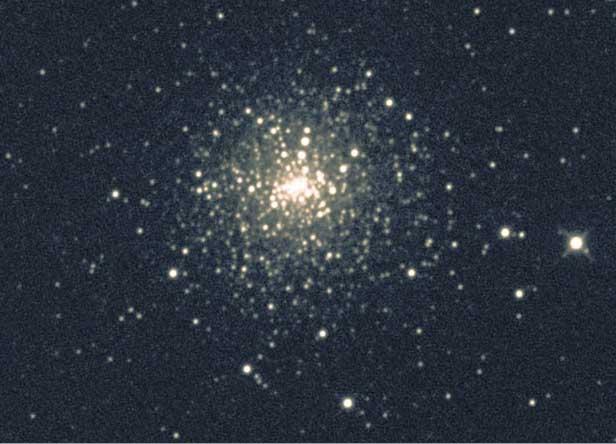
An optical photograph of the globular cluster, Messier 30. CfA astronomers have studied stars near the very center of M30, and found one that is an X-ray emitting binary in which one member is a neutron star.
Globular clusters are roughly spherical ensembles of stars, as many as a million stars in some cases, that are gravitationally bound together in groups whose diameters can be as small as only tens of light-years. For comparison, the closest star to our Sun is about four light-years away. Globular clusters are typically located in the outer regions of galaxies. The Milky Way galaxy has about 200 globular clusters orbiting it. The stars in globular clusters are highly concentrated towards the centers, where they swarm around in complex motions determined by gravity. Globular clusters are interesting in their own right as being home to some of the oldest known stars. They also help astronomers decipher how galaxies evolve because collisions between galaxies appear to be relatively commonplace, and globular clusters participate in those interactions from sensitive locations in the galaxies' halos. Globular clusters provide an important laboratory for studies of stellar evolution because their rich isolated population of stars are all about the same age. And not least, because of their very high density of stars, globular clusters are key places to study how stars interact with each other.
Messier 30 is a globular cluster in the Milky Way, and is one of only about twenty-one globular clusters that show evidence for extraordinarily high densities at its core -- perhaps hundreds of thousands of solar masses in a volume about a light-year on a side, one of the highest density environments in the galaxy. In such a crowded space, stars are expected to interact with each other frequently. CfA astronomers Jonathan Grindlay and Peter Edmonds, together with three colleagues, have combined new Chandra X-ray Observatory data with optical images from the Hubble Space Telescope and ground-based facilities to discover and study three stars only a few tenths of a light-year from the central core, and another six only about one and one-half light-years from the core.
The astronomers find that one of these sources is actually a binary in which one of the two stars is a neutron star: the small, compact object remaining after a certain type of massive star explodes as a supernova. Made up predominantly of neutrons, neutron stars are about a hundred trillion times more dense than water. Models of globular clusters suggest that as stars whiz past each other in the crowded central regions they occasionally join into a binary. The newly discovered binary may be just such a couple. The results, besides providing remarkable new information on the innermost parts of a globular cluster's core, also help to confirm and extend models of how stars interact with one another, and with their environments.